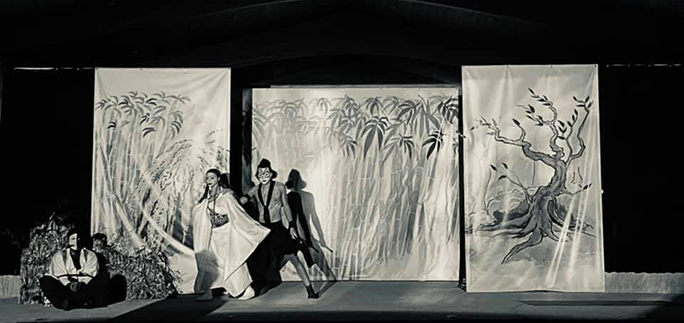I could point to any number of issues that people disagree vehemently about.
Whether it’s the latest conspiracy theory or debating the color of a dress with strangers over the internet, everyone brings their unique perceptions and levels of argumentative passion. With most issues, you can agree to disagree at the point of impasse, and then move on with your life.
But when four unreliable witnesses give drastically different first-hand accounts of a rape and murder, and someone may be put to death over the crime, that’s not a debate easily shrugged off. We have to dig into motivations behind those alternative realities and the unfortunate mutability of truth, or “truth.”
Different versions of the “truth” spin like ancient fake news in Narçisse Theatre’s season opener, “Rashōmon,” a psychological thriller from a 1950 film set in 8th-century Japan. Told through traditional kabuki theater style, four eyewitnesses describe a rape and murder scene from four drastically different points of view. One character even comes back from the dead through an African tribal dance to give their account.
Before we meet any of our eyewitnesses, we first meet the three people waiting at the gate of Rashōmon: the Priest (Samuel Eisenmuth), the Wigmaker (James Mitchell) and the Woodcutter (Aaron Bomar). Think of these three as the talking heads of the day, both narrating and analyzing the story and all its points of view. They serve as the fact-checkers of their day, intermingling their own biases. Like sinister magpies perched on a clothesline, their gossip and judgments continuously oscillate the truth along a spectrum.
Our four eyewitnesses/participants in the crime scene very capably demonstrate their talents for high drama, especially in the stage combat scenes. Tajomaru (the bandit, played by Stiles Everett), Kimune (the wife, played by Erika Eberly), Takehiko (the samurai, played by Paul Hood) and the Woodcutter (Bomar), all convincingly pull distinctive elements into each version of the story to alter it enough, yet still make each somehow believable.
Along with the ever-shifting truth is audience sympathy that head-hops depending on who the perceived victim is, and which truth presents as stronger. In discerning the truth, it’s important to note the cultural norms of the day regarding suicide, honor and the lack of a #metoo movement. Our own lenses do not necessarily bring the picture of 8th-century Japan into sharp focus.
The somber lighting and shadows on-set are symbolic of the hazy understanding intended for “Rashōmon.” The monochromatic visual elements of the settings and costumes hit notes of an incredibly elegant KISS concert with much more intentional choreography (Yuko Hamada and Dena McKell) and traditional, sometimes discordant Japanese music by Jonathan Frazier. Within a world we wish could be all black and white, we see smatterings of gray thrown in, intentionally symbolizing subjective reality.
Artistic director and founder of Narçisse Theatre Company, FL Henley, chose this play “in response to what I saw when looking at society during the lockdown… a society split between those living in an objective, unpleasant reality and those choosing to live in an alternate reality comprised of a blending of tribalism, demagoguery and personal belief.”
The play’s Wigmaker said, “Let’s not argue about right and wrong while we are hanging in here.” But it’s not so easy for the rest of us to agree to disagree. One of Henley’s goals is to make audiences “feel challenged, uncomfortable, walking away with the types of questions that cause psychological distress.”
Mission accomplished on making the audience think about deeper existential questions, and well done to all the performers for translating a difficult concept into something tangible for the audience. My plus-one and I are still spelunking deeper implications of truth v. perception via our longest text thread ever, and our list of questions is growing faster than any forthcoming answers. This play will undoubtedly leave its mark on you, too.
P.S. The story left an impression on the psychological community when it first aired in 1950. After the film, the phrase “Rashōmon Effect” entered our cultural lexicon, describing an instance when the same event is described in significantly different (often contradictory) ways by different people who were involved. The more you know.
“Rashōmon” runs Sept. 10 and 11, each evening at 7:30 p.m., Italian Lake Park, Harrisburg. Don’t forget to bring lawn chairs, insect repellant and a little something for the donation bucket. No ticket or reservation needed. Find more information at https://www.narcissetheatre.org/ and on Facebook.
If you like what we do, please support our work. Become a Friend of TheBurg!





